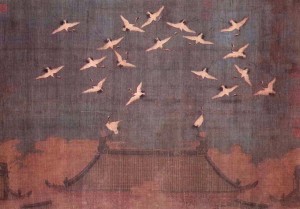“吉祥仙鹤” (Auspicious Crane)是徽宗的画。画上有很多鹤。在中国文化,鹤的意思是长寿和吉祥。鹤也意味着健康和幸福。所以在中国的画,画家都很喜欢画鹤。它的背景是蓝色的。它也有瓦屋面。瓦屋面是红色和绿色的。天上有黄色的云。白和黑色的鹤在中间,所以我们喜欢看这幅画的中间。
徽宗(1082-1135)是宋朝第八个有名的皇帝。 他有名是因为他觉得道教是真好的。他禁止佛教。除了皇帝以外、他也是一个诗人、画家、书法家音乐家。他很喜欢画鸟和花。
“Auspicious Crane”是很平静的画儿。鹤飞来飞去。可是在红色的瓦屋面两只鹤没有飞来飞去。所以它们的协调优美。背景是用丝绸做成的。我觉得蓝、黄、黑、白、红的颜色的协调很好漂亮。我觉得这幅画儿的意思是快乐最后会来。虽然在我们的人生我们都有很多黑云,也有很多烦恼,但是快乐最后会来。
“Auspicious Crane” is Huizong’s painting. It has a lot of cranes. In Chinese culture, cranes mean longevity and auspiciousness. It also means health and happiness. So, in many of Chinese paintings, artists like to draw cranes many times. The background is blue. It has a tiled roof. The tiled roof is red and green colored. In the sky, there are yellow clouds. Black and white cranes are in the middle, so our view is focused on the middle.
Huizong is famous eighth emperor of Song Dynasty. He is famous because he believed that Taoism was the best. He prohibited Buddhism. In addition to being an emperor, he was also a poet, painter, calligrapher, and musician. His primary focus of his paintings were birds and flowers.
“Auspicious Crane” is very calming painting. Cranes are flying. But at the red roof, two cranes are not flying. So their position creates a balance that is beautiful. The background is made of silk. The blue color of the silk makes the painting soft. I believe that blue, yellow, black, white, and red colors all coordinate together to create a beautiful painting. I believe that this painting means happiness will come. Despite the many clouds and worries in our life, in the future, the happiness will come.

